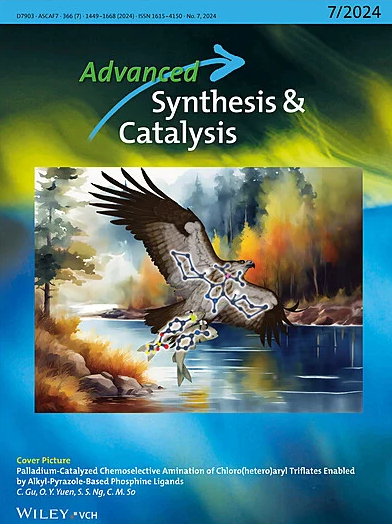揭示了四氢吡喃基二肽催化剂的催化内非共价相互作用
IF 4.4
2区 化学
Q2 CHEMISTRY, APPLIED
引用次数: 0
摘要
在本文中,我们描述了基于糖氨基酸(SAAs)的双功能有机催化剂的微小结构修饰如何改变催化剂内的非共价相互作用(nci)网络,从而导致其催化活性的显著变化。这是由于催化剂内NCIs引起的构象变化,反映在反式β -硝基苯乙烯的Michael加成速率决定步骤的过渡态中。通过动力学实验、构象分析和DFT计算,我们发现在四氢吡喃环的C4位置存在甲氧基,与不含甲氧基的催化剂相比,催化活性降低了五倍。此外,我们已经确定了不同的催化剂内NCIs,包括吸引和排斥,它们驱动构象变化,最终改变反应速率和对映体选择性决定步骤的过渡态的能级。本文章由计算机程序翻译,如有差异,请以英文原文为准。
Disclosing the Intra‐Catalyst Non‐Covalent Interactions in Tetrahydropyran‐Based Dipeptidic Catalysts
Herein, we describe how minor structural modifications to our bifunctional organocatalysts based on sugar amino acids (SAAs) can alter the network of non‐covalent interactions (NCIs) within the catalyst, leading to significant changes in their catalytic activity. This is attributed to the intra‐catalyst NCIs, which induce conformational changes that are reflected in the transition state of the rate‐determining step of the Michael addition of aldehydes to trans‐β‐nitrostyrenes. Through kinetic experiments, conformational analysis, and DFT calculations, we found that the presence of a methoxy group at the C4 position of the tetrahydropyran ring reduces the catalytic activity by a factor of five compared to the catalyst without the methoxy group. Additionally, we have identified the different intra‐catalyst NCIs, both attractive and repulsive, that drive the conformational changes, ultimately modifying the energy levels of the transition states of the rate‐ and enantioselectivity‐determining step of the reaction.
求助全文
通过发布文献求助,成功后即可免费获取论文全文。
去求助
来源期刊

Advanced Synthesis & Catalysis
化学-应用化学
CiteScore
9.40
自引率
7.40%
发文量
447
审稿时长
1.8 months
期刊介绍:
Advanced Synthesis & Catalysis (ASC) is the leading primary journal in organic, organometallic, and applied chemistry.
The high impact of ASC can be attributed to the unique focus of the journal, which publishes exciting new results from academic and industrial labs on efficient, practical, and environmentally friendly organic synthesis. While homogeneous, heterogeneous, organic, and enzyme catalysis are key technologies to achieve green synthesis, significant contributions to the same goal by synthesis design, reaction techniques, flow chemistry, and continuous processing, multiphase catalysis, green solvents, catalyst immobilization, and recycling, separation science, and process development are also featured in ASC. The Aims and Scope can be found in the Notice to Authors or on the first page of the table of contents in every issue.
 求助内容:
求助内容: 应助结果提醒方式:
应助结果提醒方式:


